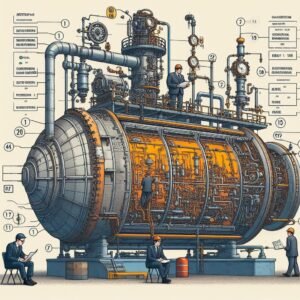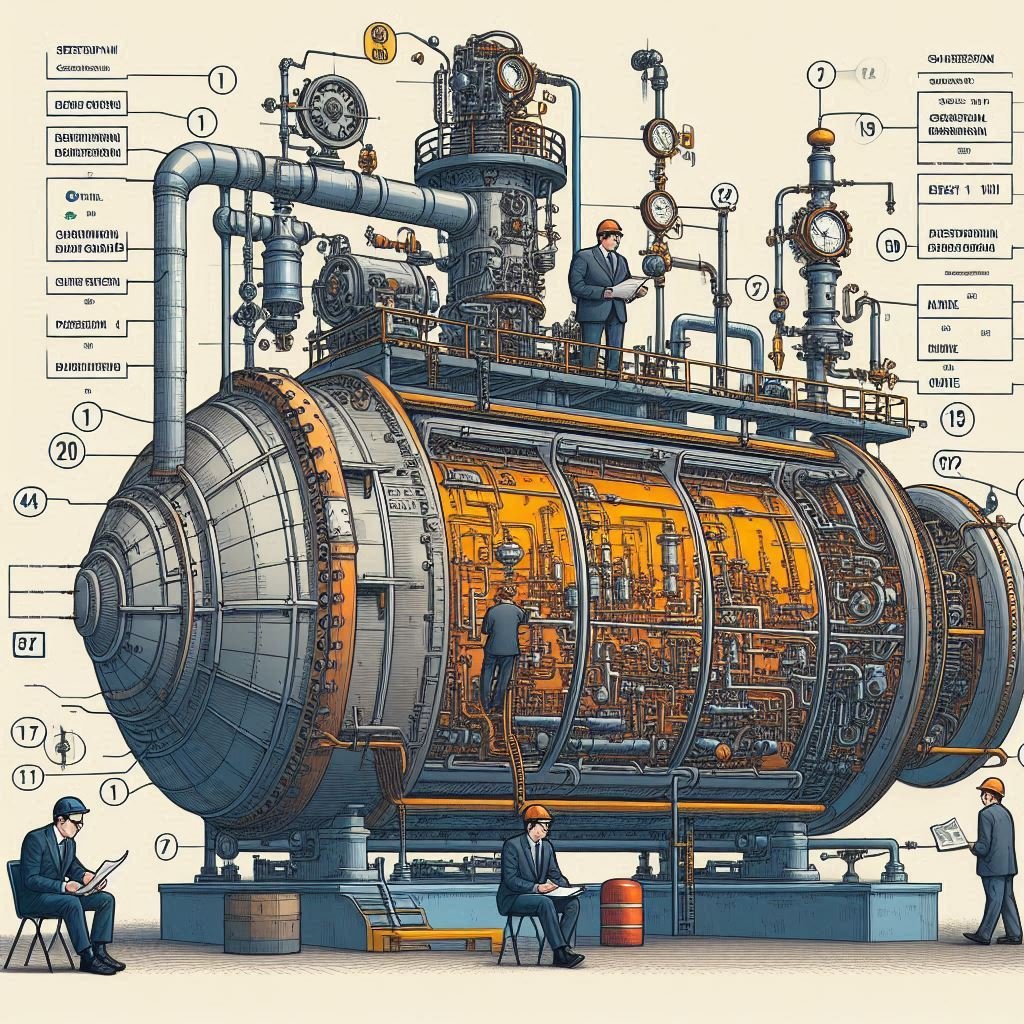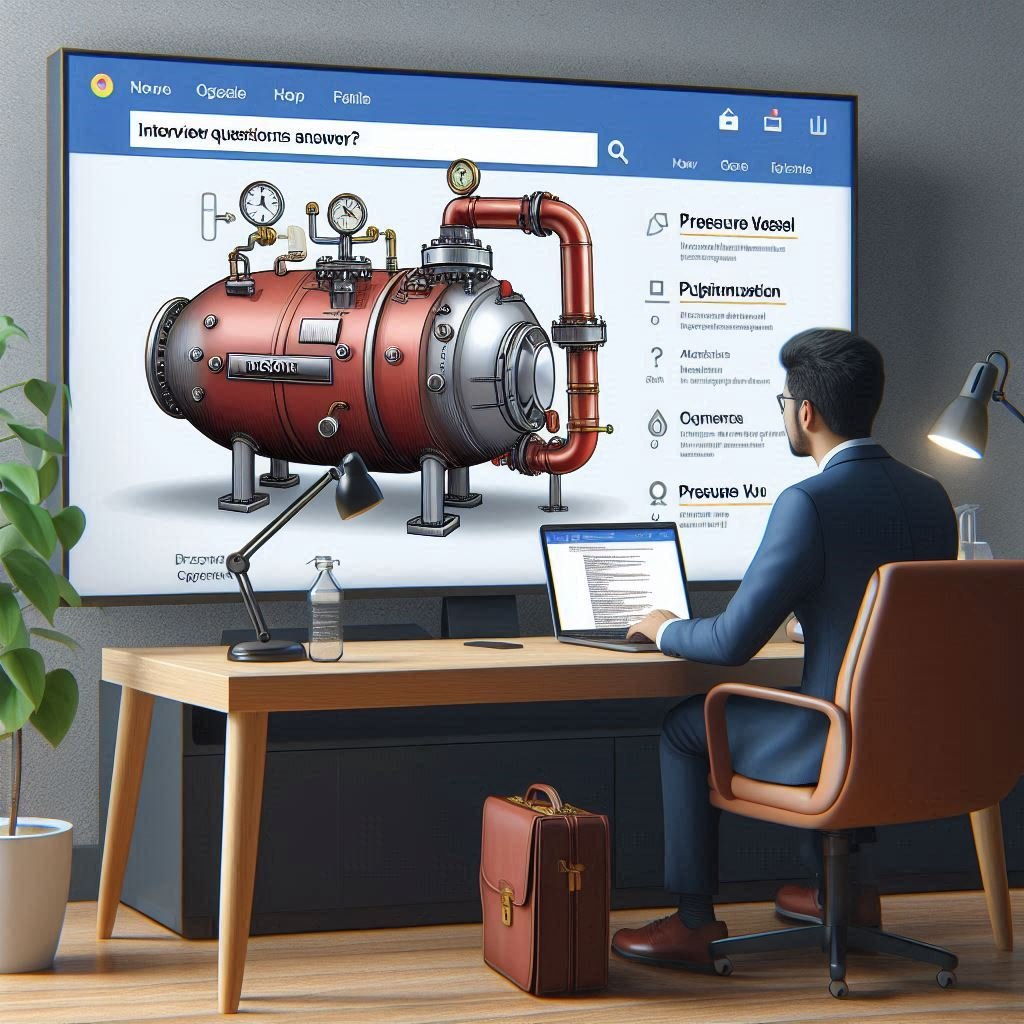Introduction to Materials & Pressure Vessels:
Understanding the critical interplay between materials and pressure vessels is essential for ensuring safety, reliability, and compliance in various industrial applications. Pressure vessels, often subjected to extreme conditions, require meticulous selection of materials to withstand high pressure and temperature while resisting corrosion and mechanical stress. ASME Section VIII provides comprehensive guidelines that dictate the responsibilities of users, manufacturers, and inspectors in the material selection and verification process for pressure vessels. This set of interview questions and answers delves into these key aspects, highlighting the importance of appropriate materials in the design, manufacture, and inspection of pressure vessels.

General Requirements of Materials & Pressure Vessels:
- Q: What are the user responsibilities in terms of material selection for a vessel under ASME Section VIII?
- A: The user or their designated agent must establish the design requirements for the vessel, which may include the selection of materials. It is recommended that the user ensures that the materials selected are suitable for their intended purpose.
- Q: What should the manufacturer consider when selecting materials for a vessel?
- A: The manufacturer must select materials based on Code requirements and design parameters specified by the user. Additionally, the manufacturer should consider the suitability of the material for a specific application, including safety and operational factors.
- Q: What are the requirements for an authorized inspector regarding materials?
- A: Authorized inspectors must verify that materials meet the tolerances specified in the material specification, ensure proper identification through Material Test Reports, verify proper repair of any material imperfections by welding, and inspect all materials for proper identification.
Material Selection and Suitability
- Q: What factors should be considered in material selection for pressure vessels?
- A: Material selection should consider the retention of satisfactory mechanical properties and resistance to corrosion, erosion, and oxidation. The selected material must meet the specific application requirements, even if it complies with the Code.
- Q: What does the Code emphasize regarding material selection?
- A: The Code emphasizes safety rather than operability. A material may meet Code requirements but still not be suitable for a particular application. The Code is not intended to replace design competency.
Requirements Governing Permitted Materials for Pressure Vessels
- Q: Where can the general requirements for materials be found in ASME Section VIII, Division I?
- A: General requirements are found in Subsection A, special material requirements based on fabrication method and service type are in Subsection B, and supplemental requirements for particular materials are in Subsection C.
- Q: How do mandatory appendices and code cases apply to material requirements?
- A: Mandatory appendices discuss special application requirements, and code cases may apply as permitted by contract or jurisdictional authority. Subsection C’s requirements take precedence over Subsection A’s requirements when addressing specific materials.
General Requirements UG-4
- Q: What are the stress-related requirements for materials under UG-4?
- A: Materials subjected to stress must conform to Section II specifications and be acceptable under Subsection VIII as listed on the stress tables or permitted by a code case. Exceptions are listed in UG-9, UG-10, UG-11, and UG-15.
- Q: What is defined as “weldable quality” in material selection?
- A: Weldable quality means that the material is suitable for welding and meets specific requirements. Non-pressure part materials must be of weldable quality according to UW-5(a).
- Q: What must be done if a material is not listed on the stress tables?
- A: If a material is not listed on the stress tables, it may not be used unless it has been submitted to and approved by the Boiler and Pressure Vessel Committee according to Appendix B, including providing necessary mechanical properties, weldability, physical properties, and patent information.
Requirements for Material Testing and Examination
- Q: What types of tests are required for materials under Section II?
- A: Required tests include chemical analysis, mechanical property testing (tensile, yield, elongation, hardness, bend, flattening, flare, crush, guided bend, Charpy impact), hydrostatic testing, ultrasonic testing, eddy current testing, and magnetic particle testing.
- Q: What are the Charpy impact testing requirements under UG-84?
- A: Charpy impact tests are required for all weldments and materials subject to stress unless exempted. Tests must conform to SA-370, and if a vessel test plate fails, reheat treatment and retesting are permitted.
Material Test Reports and Certificates of Compliance
- Q: What information must a Material Test Report contain?
- A: A Material Test Report must include results of all tests required by the material specification, any supplementary requirements, identification of the material, and applicable heat numbers.
- Q: When is a Material Test Report required?
- A: A Material Test Report is required for plate materials as specified, when specifications are completed by entities other than the material manufacturer, and when Section VIII requirements exceed the material specification requirements.
- Q: Are welding materials required to have a Material Test Report?
- A: Welding materials do not need a Material Test Report if the container is marked per Section II, Part C, or is marked and traceable to materials used in the Welding Procedure Specification (WPS).
Special Material Considerations
- Q: What are the requirements for materials outside the size and thickness limits of Section II specifications?
- A: Such materials may be used if they comply with other specifications and no size or thickness limitations are listed in the stress tables. If properties vary with size or thickness, they must conform to the closest listed requirements.
- Q: What is the significance of using ERW pipes and tubes?
- A: Electric Resistance Welded (ERW) pipes and tubes without filler material are considered materials under Section VIII, which simplifies compliance with material requirements.
- Q: What is the rule of thumb regarding permissible materials?
- A: If no welding is involved, the item is considered a material. Care must be taken to use proper stress values and temperature considerations, as well as footnotes and specific requirements in each subsection.
- Q: How does the Code define parts versus materials, and what are the documentation requirements?
- A: The distinctions affect the degree of documentation required. Pressure vessel parts requiring inspection must be accompanied by a Partial Data Report certified by an Authorized Inspector, except as permitted by specific subsections.
Exemptions and Special Requirements
- Q: What are some common exemptions for Charpy impact testing?
- A: Exemptions include P-1 Grade 1 or 2 materials under UG-20(f) when certain conditions are met, UCS-66(a) exemptions based on thickness and temperature combinations, and specific exemptions for nonferrous and high alloy steel materials listed in various subsections.
- Q: What additional requirements apply to welded components exceeding specific thicknesses?
- A: Welded components exceeding 4 inches in thickness must be impact tested, and those exceeding 6 inches attached by bolting must be impact tested if the design temperature is below 120ºF.
- Q: What are the requirements for material certification when using unidentified materials?
- A: Unidentified materials can be recertified by comparing original manufacturer’s data with SA specifications, performing all required tests and treatments, or complying with UG-10 provisions for recertification.
- Q: What are the requirements for material testing and examination under UG-15?
- A: UG-15 may require testing and examination for product forms not covered by stress tables, and results must be reported in the Material Test Report.
Specific Material Requirements by Class
- Q: What are the requirements for carbon steel materials like SA-36 and SA-283 under UCS-6?
- A: These materials can be used for pressure parts if the vessel is not for lethal service, not an unfired steam boiler, design temperature is between -20ºF and 650ºF, and plate thickness does not exceed 5/8 inch if strength welding is used.
- Q: What are the considerations for low-temperature applications under ULT and UHT-82?
- A: ULT lists special restrictions for low-temperature applications, and UHT-82 lists restrictions for vessels with enhanced tensile strength due to heat treatment.
Q: What does the Material Test Report (MTR) provide information about? A: The MTR provides information regarding the material specification, tests, examinations, repairs, heat treatments, supplementary and special requirements, identification of material, and the heat number if applicable.
- Q: When must a Material Test Report be provided?
A: An MTR must be provided for plate materials as specified, when specification requirements are completed by other than the material manufacturer (except UG-4, UG-10, UG-11, UG-15), and when the requirements of Section VIII exceed or supplement the material specification. - Q: Are welding materials required to have a Material Test Report?
A: Welding materials need not have an MTR if the container is marked in accordance with Section II, Part C, or if the container is marked and traceable to materials used in the Welding Procedure Specification (WPS). - Q: What is a Certificate of Compliance in the context of Section VIII materials?
A: A Certificate of Compliance is a written statement from a material manufacturer or supplier certifying that the material supplied is in compliance with a material specification. - Q: Are Certificates of Compliance always acceptable for materials used in pressure vessels?
A: Certificates of Compliance may or may not be acceptable depending on the specific requirements of the material and the code. - Q: Are Certificates of Compliance always acceptable for materials used in pressure vessels?
A: Certificates of Compliance may or may not be acceptable depending on the specific requirements of the material and the code. - Q: What are the five categories of material requirements in Section VIII, Division I?
A: The five categories are General Requirements (UG-4), Material Requirements (UG-4/8), Parts Requirements (UG-11), Welding Material Requirements (UG-9), and Requirements for Unidentified Material (UG-10). - Q: What is the primary concern of the ASME Code regarding materials in pressure vessels?
A: The primary concern of the ASME Code is safety, ensuring materials meet the required specifications for safe operation. - Q: How does the Code address the suitability of materials for specific applications?
A: The Code specifies that materials must retain satisfactory mechanical properties and resist corrosion, erosion, and oxidation, but it does not ensure operability for every specific application. - Q: What must manufacturers consider in addition to Code requirements when selecting materials? A: Manufacturers must consider the suitability of materials for specific applications, beyond just meeting the Code requirements.
- Q: What must Authorized Inspectors verify about materials used in pressure vessels?
A: Authorized Inspectors must verify that materials conform to specifications, compare the Material Test Report to the material and markings, ensure proper identification, and verify proper repair of material imperfections. - Q: What is the significance of UG-15 in the context of material requirements?
A: UG-15 provides for the use of an item when the specific product form is not referenced by Subsection C but is listed in Section II as another product form of a specification listed in Subsection C. - Q: What does UG-8 cover in Section VIII?
A: UG-8 covers special requirements for pipes and tubes, including finned tubes. - Q: What are the requirements for castings according to UG-7?
A: Allowable stress values for castings must be multiplied by a casting quality factor as per UG-24, with cast iron being an exception to this requirement. - Q: What does UCS-6 specify about the use of SA-36 and SA-283 materials?
A: UCS-6 allows the use of these materials for pressure parts under specific conditions, such as not being used for lethal services or unfired steam boilers, with design temperatures between -20ºF and 650ºF, and plate thickness not exceeding 5/8”. - Q: What are the special restrictions listed in ULT and UHT-82?
A: ULT lists restrictions for low temperature applications, while UHT-82 lists restrictions for vessels with enhanced tensile strength through heat treatment. - Q: What are the distinctions between parts and materials in Section VIII?
A: The distinctions, discussed in UG-8 footnote 3, UG-90 (b)(4), and UG-11 (i), affect the degree of documentation required for each. - Q: What does UG-11 cover regarding miscellaneous pressure parts?
A: UG-11 covers requirements for the use of fittings, couplings, flanges, weld necks, and caps, with specific provisions for standard and non-standard parts. - Q: What does UG-10 provide for unidentified material?
A: UG-10 provides for the recertification of unidentified materials or those identified with a specification not permitted by the Code, ensuring they meet acceptable standards through testing and treatment. - Q: What information must be reported in the Material Test Report for plates?
A: Results of material tests, including chemical analysis, mechanical properties, and any supplementary requirements, must be reported. - Q: What are the types of material tests required by Section II?
A: Tests include chemical analysis, tensile, yield, and elongation testing, hardness testing, bend tests, flattening, flaring, and crush testing, guided bend tests for weld filler metal, Charpy impact testing, hydrostatic testing, ultrasonic testing, eddy current testing, and magnetic particle testing. - Q: What are the Charpy Impact Testing requirements under UG-84?
A: Charpy Impact Tests are required for all weldments and materials for vessel parts subject to stress unless exempted, with specific requirements for test procedures and acceptance criteria. - Q: What exemptions from impact testing are provided under UG-20(f)?
A: Exemptions include P-1 Grade 1 or 2 materials with specific thickness and design temperature criteria, vessels tested per UG-99(b), and those not subject to thermal or mechanical shock or cyclical loading. - Q: What are the UCS-66 exemptions for impact testing?
A: UCS-66 exempts materials if the minimum design metal temperature and thickness combination falls above the applicable curve, allows temperature reductions if thickness exceeds requirements, and exempts specific materials like ferritic steel flanges, nuts, and thin materials. - Q: What does UCS-68(c) allow regarding impact testing exemptions?
A: UCS-68(c) allows a 30ºF reduction in impact testing exemption temperature if post-weld heat treatment is performed when not a Code requirement. - Q: What is the significance of UHA-51 in high alloy steel materials?
A: UHA-51 lists exemptions for impact testing and other requirements for high alloy steel materials, providing specific guidelines for their use. - Q: What does UNF-65 cover regarding nonferrous materials?
A: UNF-65 lists exemptions for impact testing and other requirements for nonferrous materials such as aluminum alloys, copper, nickel, cast aluminum, titanium, and zirconium.
You can read other blogs on Interview questions at www.jobinterviewqs.com/blog







